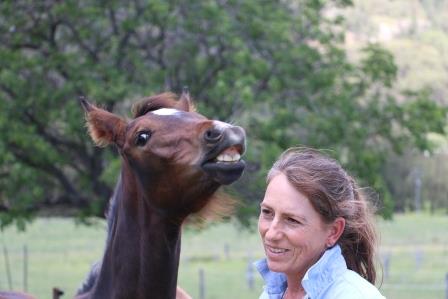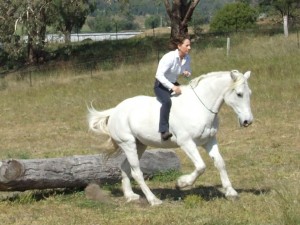Forever on my quest to find better ways to be with horses, I have been exploring better ways to motivate horses and ways to teach and explain to others how to motivate and inspire horses so that we can have happier, more enthusiastic and exuberant horses. When our horses are happy and enjoying their training more we will also enjoy the experience more. Following are some of the results of my research, thinking and experimentation with horses.
I believe that to motivate and inspire horses we can have two main types of motivation, intrinsic (internal) and extrinsic (external motivation). Intrinsic motivation refers to motivation that comes from inside an individual rather than from any external or outside rewards, such as money or grades in a human or food rewards or scratching and grooming for example with a horse. These horse rewards could also work with people too.
Intrinsic motivation comes from the pleasure one gets from the task itself or from the sense of satisfaction in completing or even working on a task. This motivation is by far the most important. Things that will intrinsically motivate a horse will be the connection and feeling of compassion and understanding that a horse can feel from the human or the mental stimulation that can be provided by the human through the training or riding, as most domesticated horses especially when not living in a larger herd situation and on large acreage are bored or mentally unstimulated.
At a physical level, when the horse starts to use its body in a correct biomechanical way the feeling of moving, exercising and having energy flowing through the body feels good. In feldenkrais we learn to move with effortlessness and ease and in a unified way so that the experience of moving itself feels pleasurable. In Aikido, the martial arts that I learn, the feeling of the energy flowing through the body as things get more dynamic and flowing, feels energizing and invigorating.
The good feeling in our minds and our bodies after doing physical activities where the movement has been balanced, unified, energizing and flowing is intrinsically motivating. This can also include stretching our body out of its comfort zone and exerting ourselves cardiovascularly or stretching muscles in a positive way, similar to the good feeling we can have when we have had a game of sport or gone for a run, this can all be intrinsic motivation. If done in the right way, movement and exercise can all be healthy, healing and therapeutic, which is intrinsically motivating and the same can be for the horse. Correct biomechanical movement, provides this aspect of intrinsic motivation. Incorrect biomechanical movement and moving and exercising and exerting the horse in an unhealthy way, will have the opposite effect and be very unmotivating for the horse.
Extrinsic or external motivation for horses could be feeding them treats and this can be a great way to motivate horses when used appropriately and as a support for intrinsic motivation. The feeling of well-being that comes with intrinsic motivation will always ultimately outweigh extrinsic motivation, because if the feeling of doing the activity is too uncomfortable food treats for example will never be enough to motivate or inspire a horse. However, when combined with intrinsic motivation food treats can be highly motivating especially when they are used as a positive reinforcement as opposed to a reward or a lure. The differences are explained below.
Punishments and Rewards come after a behaviour has been executed as opposed to positive and negative reinforcement which occurs in the exact moment that a behaviour is presented. Because a punishment or reward comes after the execution of a behaviour it can’t directly change or influence a behaviour in that moment as the behaviour is already finished and it may or may not influence behaviour in the future.
Positive and Negative Reinforcement however, occurs exactly in the moment of the desired behaviour and therefore can influence the behaviour in that moment and it is also much more likely to influence future behaviours.
Luring would mean giving the treat before the desired behaviour is executed to try and encourage that behaviour to be presented, but in actual fact it can be reinforcing an unwanted behaviour.
Negative reinforcement refers to a negative consequence to discourage an unwanted behaviour and positive reinforcement refers to a positive consequence to encourage a wanted behaviour. Most horse training is based on negative reinforcement, for example making the horse more uncomfortable when they are not doing what is wanted. This can cause training in general to feel more negative to the horse, pressuring, uncomfortable and in some cases painful. Most horses and most people will be more motivated, have a more willing attitude and become more inspired by positive reinforcement – the significant positive consequence occurring as a result of a behaviour. This is the direction that I believe training should move in and I have seen great changes in horse’s motivation with increasing positive reinforcement and decreasing negative reinforcement. Working in this way also feels more enjoyable to the trainer.
Positive reinforcement is the main type of training used by dolphin and other sea animal trainers and it is also starting to be used a lot with dogs and it is great to see the enthusiasm that those animals perform with. Positive reinforcement can be the icing on the cake when added to intrinsic motivation. We want to have a good cake first but the icing can make the cake a great cake. I am excited about the possibilities of training and having happier horses through using positive reinforcement. If you want to learn more about positive reinforcement you can read a book called Don’t Shoot the Dog or Reaching the Animal Mind by Karen Pryor and how to practically introduce positive reinforcement to your horse, can be learned in my courses and can be content for future articles.
Marker Training is what I call it when we specifically mark a moment in time when the right behaviour or an attempt towards that behavior is executed. Once the animal knows the marker signal it helps the horse or animal have clarity about we want and how to reach the goal posts to win the positive reinforcement.
So Positive Reinforcement combined with Marker training and the intrinsic motivation of feeling safe and calm, feeling connected, mentally stimulated and moving with good biomechanics seem to me to be the cornerstones of good horsemanship and how to motivate horses.

